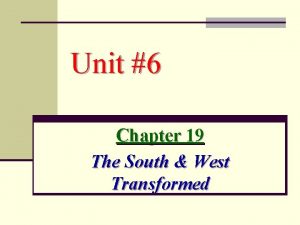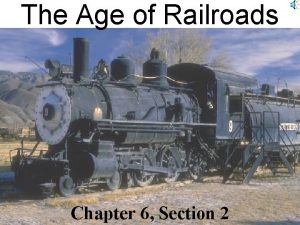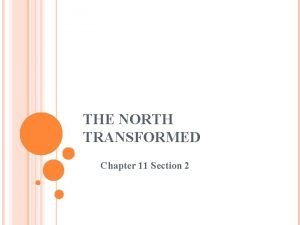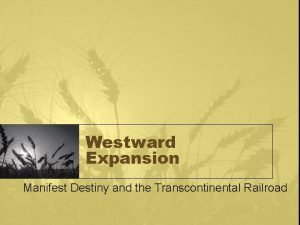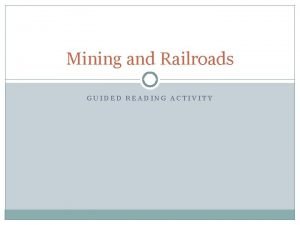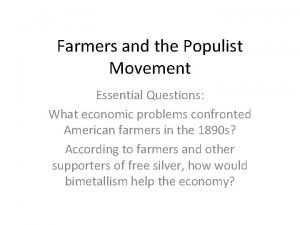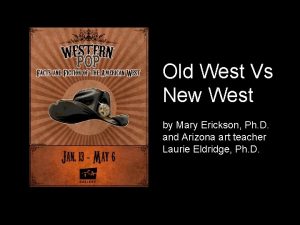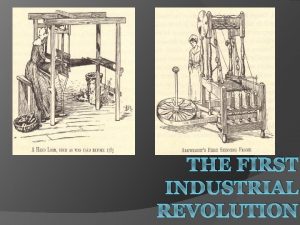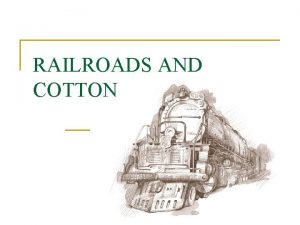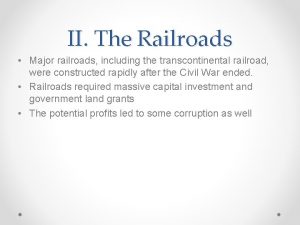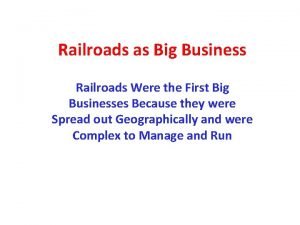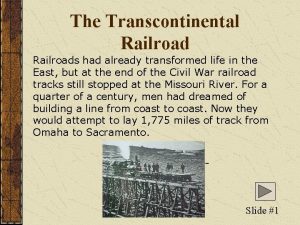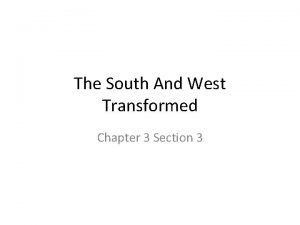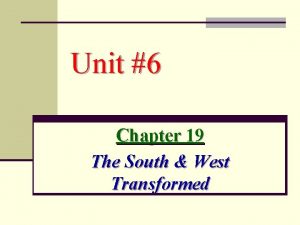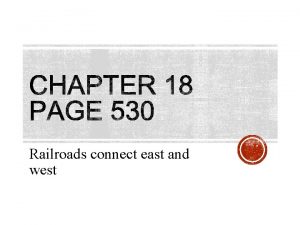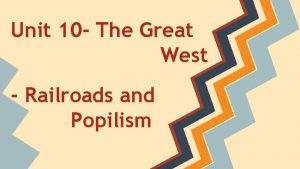The West Transformed Chapter 17 Mining and Railroads




























- Slides: 28

The West Transformed Chapter 17

Mining and Railroads – Boom and bust Before the Civil War, prospectors found gold in Nevada, which was owned by Henry Comstock. The Comstock Lode was filled with silver, and made more money in silver then gold. About $300 Million in 20 years. After the Civil War, prospectors moved west, they found ores in Montana, Idaho, Colorado and South Dakota.

Mining and Railroads Cities of tents grew around these ore mines, and were called Boomtowns. Merchants followed prospectors. – Women opened restaurants, washed clothes, took in borders. About ½ of the miners were foreign To keep justice in these towns there were Vigilantes Once the ore was extracted, the miners often moved away and the towns died.


Mining and Railroads – The Railroad Boom Before 1860, railroads ended at the Mississippi River. – The government gave subsidies to people.

Mining and Railroads Transcontinental Railroad – – – One railway went east from Sacramento, CA called the Central Pacific Railroad Another was built west from Omaha, Nebraska called the Union Pacific Railroad. They met in the middle

Mining and Railroads Towns sprang up in the west because of the railroad. – – Gold and silver came out of the mines. The Transcontinental Railroad Finding gold and silver ore in the land out to the west was what eventually inspired this railroad which spanned the continent.


– Native Americans struggle to survive People of the Plains In 1865, about 360, 000 Native Americans lived in the Great Plains people lived by gathering, hunting and fishing. When the Native Americans traded with the French and British for guns, they could travel faster and farther. Native Americans carried their belongings in Travois and lived in Tepees

Native Americans struggle to survive Plains people flowed the buffalo herds, which played a key role in the Native Americans survival. Women managed the village, cared for children, made food. Men were hunters and warriors and often led religious life.

– Native Americans struggle to survive Broken Treaties U. S. treaties promised Native Americans land, when miners and railroad crews went west, these treaties were broken. Fort Laramie Treaty-US officials wanted Native Americans to stop following buffalo, promising if they settled down, and the government would protect their land. – When this was signed, Settlers moved onto their land.

Native Americans struggle to survive Sand Creek Massacre. As a response by the Native Americans to give up their lands, they attacked supply trains and homes. – – The response to this was that about 700 people attacked the Cheyenne tribe. They raised a white flag but 100 people from the tribe were killed anyway. This massacre ignited war.

Native Americans struggle to survive The giant herds of buffalo began to die out because of railroad hunters and the price of buffalo robes. – Last stand for Custer and the Sioux Often times land on the reservation was bad and hard to farm on.

Native Americans struggle to survive The Sioux and Cheyenne lived on a reservation in the Black Hills. – In 1874 there was a gold rush and a flood of miners Sitting Bull and Crazy Horse led attacks to keep out whites Little Bighorn- A battle between Colonel George Custer and the Sioux and Cheyenne to force the Native Americans onto a reservation – Custer and all of his men died in this battle

Native Americans Struggle to survive – Other efforts of resistance When the Nez Perces were being forced onto a reservation, their Chief, Chief Joseph fled toward Canada with his people. The US Army pursued them, until their capture near Canada’s border.

Native Americans Struggle to survive Navajo Indians raided settler’s farms for livestock, to stop this, the army was called in. Eventually the Navajo were defeated. – The “Long Walk” was made by the Navajos, which was forced. Many died of disease and hunger.

Native Americans Struggle to survive The Ghost Dance – The failure of reform A Century of Dishonor by Helen Hunt Jackson. – A book that recorded the many treaties that were violated by the government. The Dawes Act – – Tried to end Native American wandering and turn them into farmers. Gave males 160 acres each to farm. They set up schools This act failed.

The Cattle Kingdom – Rise of the Cattle Industry For years wild cattle wanted the Open Range When American settlers moved to the west, they did not round up the stray herds. – When the railroads came, Texans could now take the cattle to markets In spring there were Cattle Drives- These drives lasted months to move the cattle north.

The Cattle Kingdom – Life on the Trail Cowhands-had to keep the cattle in check. – – Herding cattle was risky; they would stampede and could get taken away by a river. Cowhands worked 18 hours a day and got paid less than $1. People learned how to be cowhands because of the Vaquero – Americans learned to ride, rope and brand.

The Cattle Kingdom – The Wild West After months on the trail, cowboys would be ready for a bath, a good meal and a soft bed. This is why Cow towns were formed. Cow towns These towns soon became popular; they had dance halls, saloons, hotels and restaurants.

The Cattle Kingdom There were many myths in the west. Although there was minimal violence, people tried to advertise for the west by saying there was. – Annie Oakley even broke a stereotype and could shoot a gun as good as a man.

The Cattle Kingdom – Boom and bust of the Cattle Kingdom The cattle boom lasted from the 1860’s to the 1880’s Cattle Kingdom-The region dominated by the cattle industry and its ranches, trails, and cow towns. The boom ended when a cycle of scorching summers and frigid winters killed millions of cattle.

Farming in the West – Homesteading Homesteaders. People were given 160 acres for free if they lived and farmed on it for 5 years. – Only 1 in 3 people lasted the full 5 years Railroads gave away some of the 180 million acres it got from the government

Farming in the West – A hard life on the plains The land that people were given was hard to farm. It was fertile but covered with Sod Farmers broke through the sod with new plows made of steel by John Deere. – – Sodbusters used machines to plant crops Farmers used windmills to pump water out.

Farming in the West Whole families worked on farms. – – – Men worked from dusk until dawn Children tended animals and helped with chores Women kept the house, planted and harvested, educated the children, made clothes, preserved food and made basics like candles and soap.

Farming in the West – A last rush for land The Oklahoma Land Rush-people rushed onto land near Oklahoma City to claim it for free. – Sooners came out and claimed the best land

Farming in the West – Farmers organize Farm crisis – There was a surplus of food because too many farmers were taking grain to the market. Supply vs. Demand In many communities there were Granges. The Farmers Alliance was organized in the late 1870’s, – It set up Farm Cooperatives

Farming in the West Populists (the political party) wanted to use silver as well as gold as a basis for money supply. They believed that there would be Inflation In 1896, Democrat William Jennings Bryan ran against Republican William Mc. Kinley. – – Bryan was known as the “Great Commoner” and wanted to use silver as currency Mc. Kinley won with his gold alone standard.
 The south and west transformed
The south and west transformed The age of the railroads chapter 6 section 2
The age of the railroads chapter 6 section 2 Chapter 14 section 2 the age of the railroads
Chapter 14 section 2 the age of the railroads Difference between strip mining and open pit mining
Difference between strip mining and open pit mining Difference between text mining and web mining
Difference between text mining and web mining The north transformed
The north transformed Strip mining vs open pit mining
Strip mining vs open pit mining Mineral resources and mining chapter 13
Mineral resources and mining chapter 13 Multimedia data mining
Multimedia data mining Eck
Eck Manifest destiny railroads
Manifest destiny railroads Pearland.instructure
Pearland.instructure Guided reading activity lesson 2 the railroads
Guided reading activity lesson 2 the railroads What economic reforms did the populist party call for?
What economic reforms did the populist party call for? Railroads
Railroads Railroads
Railroads East is east and west is west
East is east and west is west Operation transformation process
Operation transformation process West wits mining top 20 shareholders
West wits mining top 20 shareholders East south east wind direction
East south east wind direction West north west wind direction
West north west wind direction Noord west zuid oost
Noord west zuid oost Old west vs new west
Old west vs new west Transformed people transform people
Transformed people transform people The transformed school counselor
The transformed school counselor What does conformed mean
What does conformed mean Istdp criticism
Istdp criticism An industry transformed
An industry transformed Exalt meaning
Exalt meaning
